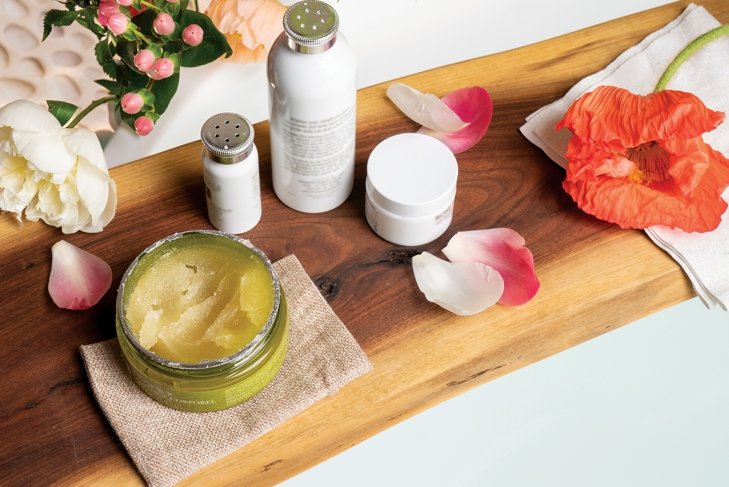
It’s summertime, and the livin’ is easy—or it should be. Here are some simple strategies to enjoy the sunshine and keep your skin safe and beautiful.
Eat your sunscreen…
Your summer skin strategy shouldn’t rely on topical fixes alone (but we’ll get to those in a minute).
Studies show that antioxidant micronutrients in food increase skin’s defence against UV radiation, support longer-term protection, and promote repair. In other words, the right foods can help keep your skin healthy—not to mention looking good. Research shows vitamins C and E, selenium, flavonoids, and polyphenols can help counteract biochemical changes that occur in skin following sun exposure.
Fortunately, you’ll get a variety of these nutrients by filling your plate with in-season summer fruits and vegetables. Be sure to include all the colours of the rainbow.
On the other hand, some foods contain psoralens, which are naturally occurring organic compounds that can amplify the effects of the sun. When you know you’ll be out in the sun, consider leaving citrus fruits and foods from the umbelliferae family (like parsnip, parsley, celery, and carrots) out of the picnic basket.
…And wear your sunscreen too
There are two types of sun protection: Chemical sunscreens absorb UV rays, while physical sunscreens prevent UV rays from penetrating skin.
Unfortunately, a 2019 FDA review indicated there is insufficient information about safety and absorption of many commonly used chemical sunscreen ingredients, including oxybenzone, octinoxate, octisalate, octocrylene, homosalate, and avobenzone. Plus, chemicals such as oxybenzone and octinoxate have been banned in some areas for the damage they may do to sensitive water habitats.
Physical sunscreens—widely considered to be the safer and more natural option—usually contain the minerals zinc oxide (ZnO) and titanium dioxide (TiO2). TiO2 is more effective for UVB rays, and ZnO is better for UVA rays, so combined they create broadband UV protection. New formulations use smaller particles to avoid the telltale white coating on skin, and research suggests that few if any of these particles penetrate viable skin cells. TiO2 inhalation, however, has been linked with lung cancer, so it’s a good idea to avoid spray or powder forms of physical sunscreens.
Research shows that oil carriers may be most effective for creating uniform and longer-lasting sun protection, so look for oils in your natural sunscreen. Oil-based sun products also have emollient properties, which means they help reduce moisture loss.
Don’t be lulled into a false sense of security by thinking your SPF15 foundation will get you through a patio lunch unscathed. It’s unlikely you put enough on to achieve the full SPF value, and sun protection must be reapplied regularly to be effective. Instead, pop a hat on your head, and make sure it has a three-inch brim. Protect lips with a balm containing coconut oil or shea butter and zinc oxide while you’re out and about.
For after-sun skincare when you overdo it, be sure you have coconut oil on hand. Studies suggest virgin coconut oil helps to halt free radical production in response to sun exposure and has anti-inflammatory effects in skin.
That leaves one question: What should you do when sun exposure starts showing up long term in your skin?
Seeing spots: When to be concerned
Freckles are reddish to light brown spots with irregular but distinct borders that result from an increase in melanin (skin pigment) production. Spots usually appear in childhood on the face, chest, neck, and arms of those with fair skin—particularly those with red hair. Freckles fade over winter months and partially disappear with age.
Dark or brown spots—aka hyperpigmentation in darker skin—are caused by excess melanin too, and they frequently appear after a pimple, bite, or other injury heals. Dark patches of skin that appear due to hormonal fluctuations—for example, during pregnancy—are also more common in darker skin tones. You can reduce both types of spots’ visibility by using sun protection.
Age spots usually appear after the age of 50 on sun-exposed skin sites and are more common in people with lighter skin. Technically known as solar lentigines, these light brown to black spots vary in size. Age spots result from melanin-producing cells multiplying and skin changing in a way that prevents removal of melanin through normal exfoliation of cells. Also known as liver spots or sunspots, these are strongly related to chronic sun exposure and associated with photodamage and an increased risk for skin cancer.
Actinic keratosis refers to small, rough patches on the skin that feel like sandpaper and may sting, itch, or burn. These patches appear in sun-exposed areas including the backs of the hands, ears, nose, lower lip, or balding scalp. Visit your doctor immediately if you see these patches as they are strongly associated with squamous cell carcinoma, the second most common form of skin cancer.
Moles are growths on the skin and may darken with sun exposure. Talk to your health-care provider if a mole changes shape (especially if the borders are irregular), colour, or size or bleeds easily.
Daily beauty prescription for summer skin
Multivitamin
Shore up your antioxidant protection with vitamins C and E, as well as carotenoids.
Borage oil
Tap into this excellent source of the anti-inflammatory fat GLA (gamma-linolenic acid) that helps stop water loss in the skin. Use as a supplement or topically to protect skin hydration.
Astaxanthin
This carotenoid helps halt free radicals associated with UV exposure, mitigates inflammation, and improves skin moisture.
Turn up your summer glow
Cleanse
Whether you spend the day in the boardroom or on the beach, remove your sunscreen and makeup before bedtime. Despite what you might have been told, you only need one cleansing product to get the job done.
Cleansers work because they contain surface active agents (surfactants) that are effective at removing both oil-based and water-based ingredients. Look for surfactants derived from natural sources like sugar and lipids, including sucrose laurate and lauryl glucoside.
Moisturize
Don’t let the dewiness of your summer skin trick you into thinking you don’t need to moisturize—because you do! Look for moisturizer ingredients that pull water into skin or hold on to what’s there without blocking pores, including jojoba, sunflower, argan, and sesame oils, as well as honey. Sandalwood oil may help to soothe irritation associated with acne.
Spritz
What feels more refreshing than a cooling spritz in the midst of a hot summer day? When choosing your summer facial mist, look for natural brands that contain ingredients such as Pyrus malus (apple extract), which provides amino acids, flavonoids, trace elements, and vitamins to nourish skin at the same time that it locks water into skin cells. Keep up the fruit theme with the natural preservative Citrus grandis (grapefruit) seed extract.
Multitask
Coconut oil can be used as a skin cleanser, moisturizer for dry skin, and hair treatment!
Natural Protection
Light skin has an intrinsic natural SPF of 3.4, while dark skin has an intrinsic SPF of 13.4. Studies show that approximately four times as much UV reaches the upper dermis (the second layer of skin cells) in people with light skin. Be aware though: Darker skin can burn and is also susceptible to skin cancer.
Enjoy iced tea made with black or green tea to reduce UV-induced erythema (redness).
While plant ingredients, including vitamins and extracts, are often found in natural sunscreens, don’t assume these ingredients will provide enough protection if you use them individually. For example, olive oil and coconut oil have natural SPFs of about 8. Likewise, topical application of ingredients like aloe.
If you’re looking for a natural approach to treating hyperpigmentation, topical use of extracts of mulberry, kiwi, and Sophora angustifolia individually has been shown in research to significantly reduce skin hyperpigmentation, with effects similar to synthetic hydroquinone.













